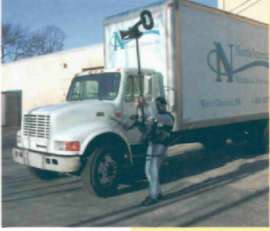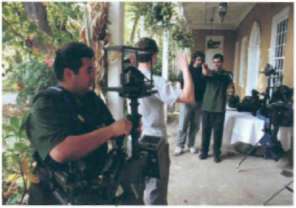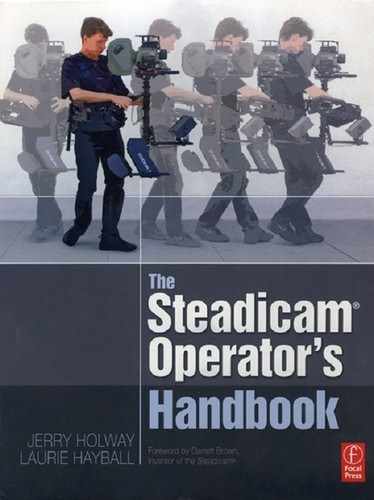Basic shot design
and the Steadicam operator
Even the best director can't describe every frame of a shot. One of the most fun and challenging parts of being a Steadicam operator is having a deep involvement in the final design of the shot. It is your responsibility to make the shot work. You are the one who has to move the camera through space. Where are you going with it? What are you looking at? For how long? With the freedom of movement the Steadicam provides, you can do almost anything; so how do you decide what the lens should frame at each moment during the shot?
What is happening in the story?
Start gathering information. Listen to the director describe the action.This is not always as simple as it sounds. The director is busy and shares very little. Sometimes he is ex-hausted and what he does tell you makes little sense If you are a day player, you have a lot of catching up to do. Hopefully you have read the script, or at least the sides for the day. This is your job. Find out what the shot is supposed to show, and the larger role it plays in the whole film.

For example: A group of boys are playing in from of a house. One of the boys goes inside and gets a gun. Any number of things could be happening here. You must be conscious of the emotional elements of the scene also. Is the boy mad at one of his friends and intends to use the gun in the yard? Or is there an outside threat he is protecting his friends against? Is there an urgency to his action? Or is it methodical?
Ask questions. A Steadicam operator, in addition to flying the camera around, is re-sponsible for a kind of performance. The speed, energy, focus that you put into the shot will define the story for the audience.
Extremely important:
You must decide the best way to configure the rig to help you achieve the shot. Don't pay too much attention when the director tells you it's
What are the specific frames?
What are the key points of the scene and how does the director want to see them? The directors job is to have a vision in his or her head — a series of moments in the story that need to be captured on film. It is your job to link these moments in a meaningful way. focusing all energy on the narrative.

Look at the shot with your eyeys

Once you have settled on the “must have” moments in the scene, it is time to consider how you will go about achieving them. Walk through the shot without the rig. Remember to get your eyes at the right height. If the camera is going to be on the floor, get down there to see problems or opportunities. Note things like backlight flares, seeing off the top or side of the set, restricted space. What lens has the director or DP suggested? This can make a big difference here. It's a good idea to carry a director's viewfinder in your kit. Having the ability to look through a specific focal length lens is extremely useful in determining your exact path making initial marks far yourself and solving problems You can accomplish without carrying the weight of the rig.
Getting the camera where it needs to so

On Four Faces of God, the director asked me to start 12 feel in the air, track across a courtyard, catch the actress in close-up as she rounds the comer, let her enter a brick building, then magically rise up to about an 8 foot lens height and peer into a window to see her crossing the lobby.
This was obviously going to be a high mode shot, but if I extended the telescoping posts to achieve the highest camera height, I wouldn't be able to get the camera at eye level for the actress's close-up.
I had to find another solution. I used ramps at the beginning and end of the shot. The result was amazing Swooping in on this character from high and far away to a close-up really gave the shot the energy it needed. Add then, just as the audience felt like they were finally going to get to know this girl, the move at the end turned the audience into spectator once again.
What is the most difficult part of the shot?
Can you configure the rig to make this rnoment easier?
For instance, if the space is tight and there are a lot of little pans you might configure the rig very short with the monitor and battery in close. If the shot has a lol of tilts, balance top to bottom with a long drop time Set the tilt head so you do the least amount of tilting.
How high or low do you need to get the lens? Is it a high, low or long mode shot? Older type Steadicam arms have a boom range of about 24 inches. G-series arms reach 32–33 inches. Know your arm's boom range and the lens heights you can reach with yourgear in all modes. Aee all of the critical frames within this range? This could be the 24 inches from your knee to your waist or from your chest up over your head.
If the range of lens heights is greater than your arm's range, can you climb a set of steps, traverse a row of appleboxes, sit down on a box, walk in a trench, or get on a dolly ora crane? Do whatever it takes to get the lens at the right height.
If no solution is readily available, you must suggest an alternate (but just as interesting) frame to replace the one that does not fit in your range.
Once you have determined whether high or low mode works best, you will also decide the length of the post, the tilt head angle, the proper inertia (fast or slow rig), and bottom heaviness (for ease of till) of the rig. Don't make these decisions in a vacuum. You must also consider the set, the path you and the rig must take through the scene. Are there any spatial limitations on the size (length, height, width) of the rig?
The camera's path and your path
The camera's path is primary. You must be committed to keeping the camera on its path at all costs. Walk through the shot wearing the rig. Determine your movement through space You may need to make a switch to Don Juan and back to avoid objects Can any thing be moved out of your way? Does it appear in the shot? Should it be flown out of your way during the shot? Whether inside or out always walk the path yon are oning to take with rig and clear any iterms mat may trip you up. Familiarize yourseif with the director's “must have” moments. Bum those images in your memory.
Do not compromise the path of the camera
because of the arrangement of the set.
Typical workshop shots in the United States involve spies, guns, drugs, and love triangles, as well as stops and starts, switches,stairs, gratuitous movement around the actors, whippans, and of course solid lock offs. Good practice for the real world.

Design the shot — what story are you telllng?
Configure the rig — for optimal heightt distance, reach (over a table)
Control your path — have items moved ii no out as needed, create your own height
Play the part — you are the audience's desire to learn aboou the chracters and the story; reveal this at an appropriate speed; think through the camera, not your body
Now it is time to rehearse
Are you clear on when you move from one place to the next, when to reframe? Most of the time an actor will move, delivera specific line, or a certain noise will cue the camera to move to the next frame. Sometimes one is asked to do something that is possible or even mechanically easy, but hard to justify or to find the right timing.
Once I was asked 10 pan off a couple at a table in a coffee shop to the guy behind the counter, but there was no specific moment or timing to motivate the move. I suggested we have a waitress' arm come in and pick up the check off the table and walk to the counter. Following the movement of her arm through the frame drew the camera to the counter, creating a visual continuity that connected the spaces and action, and also drove the speed of the pan.
If you fail to create a meaningful transition, you'll find the editor is always tempted just to cut the shot at that moment and pick it up later. Remember, you are the audience's desire to ex-perience the story. What could pique your interest and lead you to a different space in the set?
Once you have worked out your transitions, start to involve yourself in the mood of the entire scene. Don't forget that what you see on your 4 or 5 inch monitor might soon be projected onto a 40 foot screen. Even with an 8.4 inch monitor, you must work to imagine your shot on the movie screen.
You may have to alter your speed to assure it's right for the shot in its final form. Find some way to put yourself in that movie theatre, watching the film. Some operators like to imagine the musical score to help maintain a specific energy or speed during the shot.
Move wisely
One big difference between conventional operating ang Steadicam operating is how much we utilize movement to frame the subject. While there are dollies and cranes and jibs out there that also move the camera, most of the spatial movement with those devices is dond by the grips, and the conventional camera operator's choices are limited to panning and lilling. Steadicam operators san move the camera anywhere within the range of their arms and legs, and this range is easily extended by ramps, stairs, cranes, an, vehicles.
Overusing this ability to move the camera can alsa be extremely boring. There are so many examples or paes and pages of dialogue on TV shows with the cheracters walking down endless, twisting corridors, the two or three or more figures locked in the frame, never changing their position in relation to the lens. They all might as well be on a treadmill in front of a bluescreene
